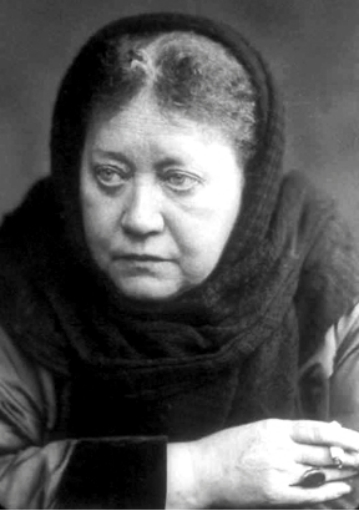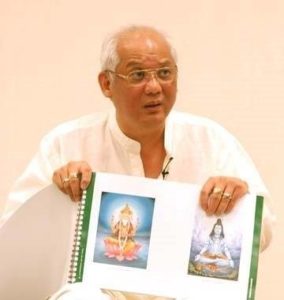Several of our articles refer to the Theosophical and esoteric teachings of writers such as HP Blavatsky, Annie Besant, CW Leadbeater, and Alice A Bailey. You may have noticed that some of our past articles have discussed concepts such as Thought Forms, the Seven Rays, Can Pranic Healing be Dangerous?, Reincarnation, and a few more others. The reader may occasionally wonder as to what is Theosophy and why we sometimes refer to the concepts while discussing the teachings of Master Choa Kok Sui.
Through the years, Master Choa has emphasized the deeper study of esoteric concepts. Master was an avid reader himself and had studied many spiritual and religious books from around the world. MCKS had advised students to read books to deepen their understanding of spirituality and related topics and recommended many looks, including Theosophy, Astara, and the Arcane School.
So, is Theosophy a new age teaching? And how is it connected to the teachings of MCKS? This article attempts to examine questions such as these in more detail.

The Theosophical Movement
Theosophical Movement, as such, is a broad term indicating organizations and philosophies of the modern era influenced by the teachings of Helena Petrovna Blavatsky (HPB) and her original Theosophical Society, founded in 1875. Theosophy in itself derives from the Greek terms θεός (theos), which roughly translated means “god” or “divine”, and σοφία (Sophia), wisdom. Theosophy has been variously translated as divine wisdom or wisdom in things divine. HPB herself stated that “theosophia properly means not knowledge of “God,” but of gods, i.e., divine, that is superhuman knowledge.”
After the passing of HPB, there have been several “offshoots” of what remains of her original Theosophy Society, which includes the Lucius Trust (formed by Alice A Bailey), the Agni Yoga teachings (by Nicholas and Helena Roerich), teachings by Manley P Hall, Franz Bardon, and others.
According to the theosophical view, every world religion is based on and comes from one and the same ancient truths and principles. Theosophy is thus meant to be a universal teaching that talks about a body of truths that form the basis of all religions. However, as religion’s pure and original teachings became corrupted and obscured by superstition and ignorance, this universal body of knowledge became distorted. The Theosophical Movement was a response to investigate and discover the eternal truths enshrined in different traditions, religions, and philosophies and offer them to the public in a purified form. Theosophists were heavily involved in the introduction of Eastern philosophical concepts (like reincarnation, karma, and yoga) into the West.
As such, Theosophy is not a religion. Theosophists are perfectly free to belong to any religion, but they also know that it is not actually essential or necessary for them to belong to or identify themselves with any particular religion. The motto of the Theosophical Movement is “There is no religion higher than Truth.” Furthermore, Theosophy is not tied to a specific religion or philosophy and, as such, does not promote any particular system or limit itself to a definite set of concepts.
The first-generation Theosophical writings consist of The Mahatma Letters to AP Sinnett and the books of HPB (notably Isis Unveiled and The Secret Doctrine), while the second-generation of Theosophical writings comprise of the works of Annie Besant, CW Leadbeater, C Jinarajadasa, Geoffery Hodson and several others. Theosophy as a body of knowledge is one which is intended to be dynamic and evolutionary.
Is Theosophy New Age Wisdom?
Having looked at the history of the Theosophical Movement, it might be worth examining the nature of theosophy. Is Theosophy “new age wisdom” or something fundamentally different?
Theosophy attempts to distill and explain the essence of inner teachings, which are fundamental and universal across a large number of religions and philosophies. According to Master KH (who has a mentor to HPB and was closely associated with the Theosophical Movement, “Theosophy is no new candidate for the world’s attention, but only the restatement of principles which have been recognized from the very infancy of mankind.” (In a previous article titled What Theosophy Teaches, we have discussed some of the fundamental ideas that were presented by multiple writers. You may feel free to go through it.)
In this article, let us look at two examples from Theosophical teachings to show their similarity with ancient esoteric philosophy. For this, we choose two Theosophical Classics.
At The Feet Of the Master
At The Feet Of The Master (1910) by Alcyone has been long acclaimed as a Theosophical classic. This book contains primary instructions given by the Guru to the disciple (Alcyone) as he was to set his feet on the spiritual path. A closer study of the text shows that there is a strong resemblance between the teachings provided in this book and the teachings contained in the Vedic scriptures. Let’s examine this closely.
For one, the Upanishads, a part of the Vedas, are ancient Sanskrit texts containing some of Hinduism’s central philosophical concepts and ideas. Some of these concepts are shared with Buddhism and Jainism. The Upanishads are commonly referred to as Vedanta. The term Vedanta has been interpreted as the “last chapters, parts of the Veda” and alternatively as “object, the highest purpose of the Veda”. The Sanskrit term Upanishad itself comes from the words “upa” (which means by) and ni-sad (or to sit down). The word Upanishad in itself translates to “sitting down near” or the student sitting down near the feet of the teacher while receiving spiritual knowledge (do note that in all Eastern traditions, the student always sits at a level which is lower than that of the teacher, i.e., the crown chakra of the student is always below that of the teacher).
Secondly, Alcyone received some specific instructions from his Guru. There were four qualifications for walking on the spiritual path, namely:
- Discrimination
- Desirelessness
- Good Conduct (six points)
- Love
Alcyone said, “I know that some of these are translated differently, as are the names of the Qualifications, but in all cases, I am using the names which the Master himself employed while explaining them to me.”
Now let’s look at the teachings of Adi Shankaracharya (788-820) for walking on the spiritual path:
- Viveka (or discernment or discrimination between the real and unreal and the true and untrue)
- Vairagya (or dispassion towards sense objects)
- Shad-Sampat (the six virtues or treasures)
- Mumukshutva (or the longing for spiritual liberation)
Notice that the first three directly map to the instructions provided to Alcyone by his teacher. Interestingly, the last qualification is also connected. Spiritual yearning or spiritual thirst comes through the crown chakra. For the crown chakra to be activated, the heart chakra must be activated first, i.e., there needs to be love. This is the same principle that is used in the procedure for the Meditation on Twin Hearts, where the heart chakra is activated before the crown chakra.
Notice that there is a strong similarity between Theosophy and other ancient traditions (in this case, the Hindu tradition). Let’s look at another example.
Three Fundamental Propositions
Adi Shankaracharya summarized the entire Vedanta philosophy in three sentences, specifically:
- Brahman (the Supreme God) alone is real (Sat)
- The world (Jagat) is unreal (Mithya)
- Ultimately, there is no difference between Brahman and the Soul (Jiva)
One of the most important books in the Theosophical literature is The Secret Doctrine by HPB. The foundation for understanding the work lies in understanding the three fundamental propositions in the Proem (or the preface to the book). The three fundamental propositions enumerated by HPB are as follows:
- An Omnipresent, Eternal, Boundless, and Immutable PRINCIPLE upon which all speculation is impossible since it transcends the power of human conception and could only be dwarfed by any human expression or similitude.
- The eternity of the Universe in toto as a boundless plane, periodically the playground of numberless Universes incessantly manifesting and disappearing.
- The fundamental identity of all Souls with the Universal Over-Soul
Did you notice that the three fundamental propositions are the same as the essence of the Vedanta, as provided by Adi Shankaracharya?
In Conclusion, Theosophy is not a New Age teaching
If you study theosophy closer, you will notice the deep roots of Theosophy as they are present in the ancient teachings of the Vedas, the Upanishads, the Sutras Patanjali Yoga, the Bible, the Torah, the Kabbalah, and many other ancient religious scriptures. Ergo, theosophy is not new-age wisdom or new-age teachings. Theosophy fundamentally represents the essence of ancient esoteric traditions.
This is one of the reasons we sometimes reference Theosophical literature in our articles.
To get a broad sense of what Theosophy teaches, refer to an older article titled What Theosophy Teaches: Understanding the Essence.
Why study Theosophy?
Master Choa himself had studied thousands of spiritual and religious books from all around the world. As a young man, Master Choa Kok Sui studied a wide range of healing arts (notably at a time when they were not yet validated as sciences), achieving a kind of encyclopedic level of knowledge on the subject matter. He also studied yoga, psychic phenomenon, mysticism, Chinese chi kung, Rosicrucian Teachings of the Ancient Mystical Order of Rosae Crucis (AMORC), Theosophy, Astara lessons, Arcane School teachings, and other esoteric sciences.
MCKS actually encouraged his students to study and read extensively. As MCKS has said in his books, studying books helps us understand deeper spiritual truths and our inner personal experiences. Also, by reading, we can stay abreast and aware of some of the latest scientific discoveries and developments across the world, deepening our knowledge.
Specifically, MCKS said, “Spiritual Books are good food for the soul. When you read a good book, the Shakti goes to you.” A deep study of spiritual books helps us to develop a sharper mind and spiritual progress.
However, MCKS also advised that not all books are great and hence, it is advisable to be selective in what we read, and not all of them will be able to impart knowledge and help us grow. Master advised students to “Be selective. Do not waste your time reading doubtful books. Most books are not fantastic. Garbage in, garbage out.”
Also, different books may contain different information that may seem to contradict each other and can sometimes be confusing for the reader. Hence, MCKS provided a list of recommended readings (which can be accessed in the appendix of his book, the Ancient Art and Science of Pranic Healing and the Arhatic Yoga Preparatory Level notes.
While it is good to read spiritual books written by other authors, do note that there are a few key points that one should keep in mind:
- Theosophical teachings, while deep and insightful, are not divine revelations (for the lack of a better term). Hence one should not “blindly swallow” the teachings.
- Any book, in general, is not 100% accurate. Hence MCKS emphasized that students exercise intelligent evaluation and discernment.
- The instructions of MCKS were to study esoteric books. MCKS never gave instructions to practice spiritual techniques (if any) contained in the books. In general, it is not considered safe to mix techniques across different spiritual schools.


0 Comments